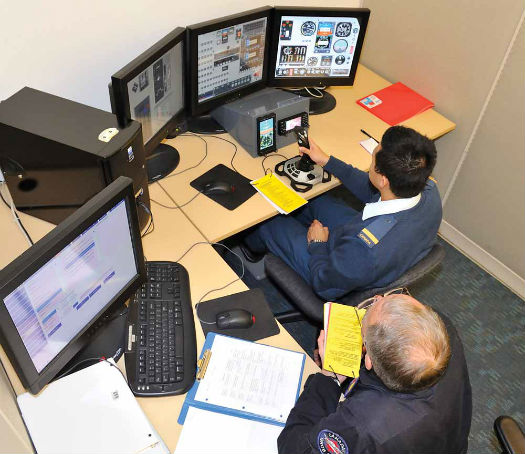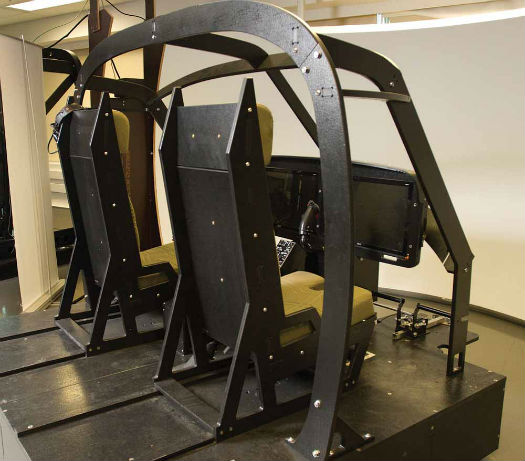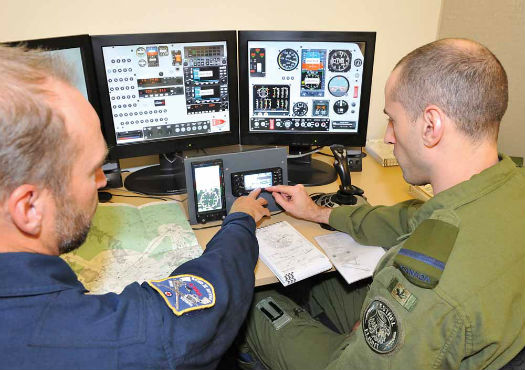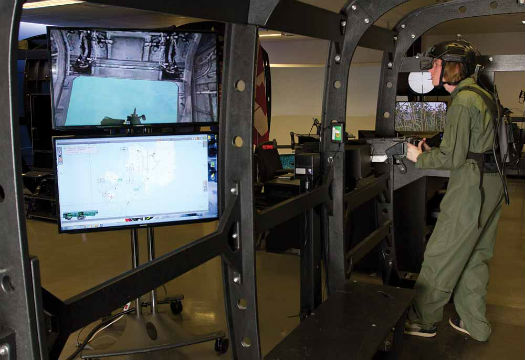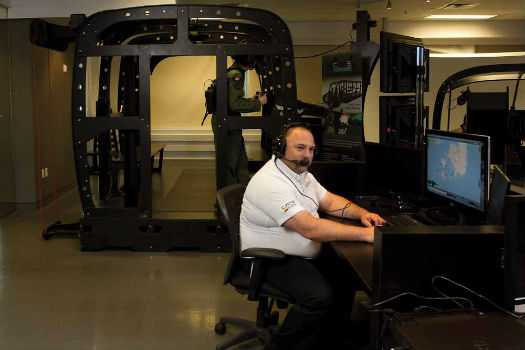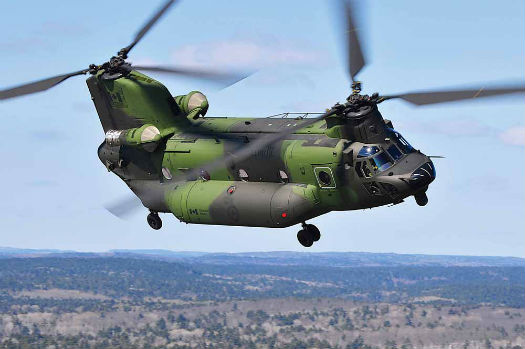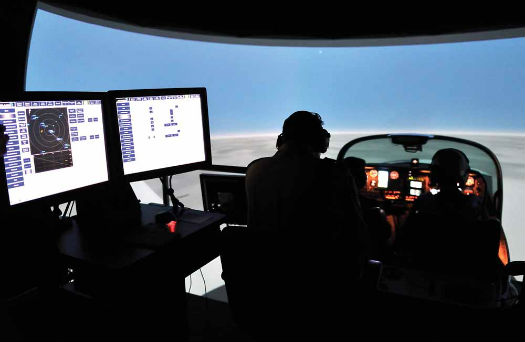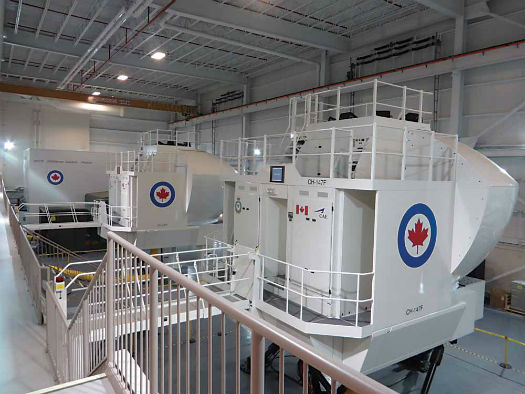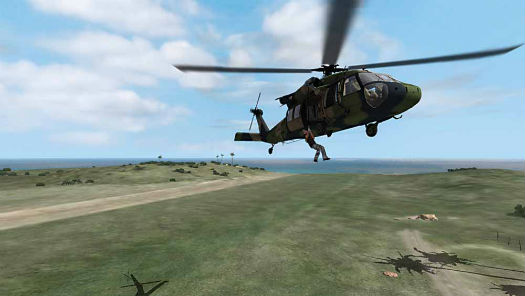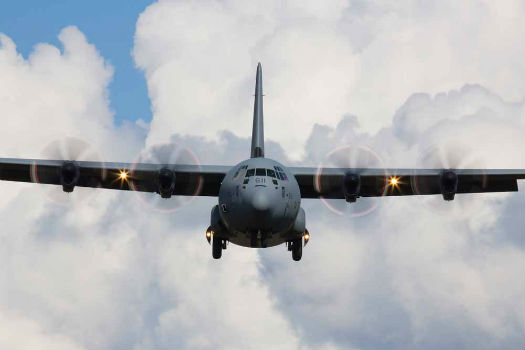Carl Daniels, Bluedrop vice president of business development. Michael Durning Photo
The explosion in simulation technology in recent years has prompted a similar transformation in Halifax-based Bluedrop Training and Simulation. Established in 1992, the company employed about 20 people for the first 18 years of its existence. But in the last five years, Bluedrop has grown more than tenfold, now employing 210 people who provide a full range of simulation strategies to the Canadian military and other customers worldwide.
Bluedrop’s office in Halifax is home to an experienced management team, 3D artists, programmers, project managers, and software and simulation engineers who develop and maintain a range of desktop course materials, virtual reality devices, and simulation technologies.
“It’s kind of our R&D centre, as well as our testing centre for anything that we’re delivering,” Scott Kaiser, Bluedrop’s director of product and development, told Skies, referencing the company’s training centre.
An instructor trains a student using a desktop GROB G120A simulator at the Southport Aerospace Centre. Cpl Vicky Lefrancois Photo
Today, Bluedrop develops a variety of simulation technologies including helmet and head-mounted virtual reality displays, a Tactical Airlift Crew Trainer (TACT), a Virtual Marshalling Simulator, and one of its most popular products, a Complete Aircrew Training System (CATS).
“CATS is a rear crew training system, so it’s a procedural trainer,” Kaiser explained. “It focuses on gunnery training and search and rescue hoist training.”
The device can be utilized as a stand-alone trainer, with an instructor acting as the pilot of the aircraft. This allows the crew to walk through training missions that mimic real life operations in a safe and controlled environment.
Bluedrop’s training centre in Halifax is used for research and development and as a test facility for every product that the company will deliver to its clients. Michael Durning Photo
“The reaction to the products is always very positive, especially from the people that are actually on the job doing those tasks day-to-day,” said Kaiser. “The whole idea of the training is to better prepare the trainees for when they get on the actual aircraft. It will never fully replace training on the aircraft, but it makes them better prepared when they actually get to that stage of training.”
A significant amount of Bluedrop’s recent growth has come through increased Royal Canadian Air Force (RCAF) spending. The company’s desktop courseware for pilot training has been particularly popular with military customers.
Bluedrop currently provides that courseware for a list of RCAF platforms and programs that includes the CC-130J Hercules, CH-147F Chinook, and the CH-148 Cyclone Maritime Helicopter Program. Bluedrop also provides courseware for the RCAF’s primary, rotary-wing and multi-engine pilot training programs, which are delivered by the defence arm of prime contractor KF Aerospace (formerly Kelowna Flightcraft). Known as the Contracted Flying Training and Support Services (CFTS) contract, all instruction takes place at the Southport Aerospace Centre in Southport, Man. Bluedrop, along with KF Aerospace, holds the RCAF training support contract until 2027.
Every new RCAF pilot trains at the Southport Aerospace Centre using equipment that Bluedrop has a hand in creating. Cpl Vicky Lefrancois Photo
“That program is important for us because every Canadian pilot that goes through the training system goes through our training program,” said Carl Daniels, Bluedrop’s vice president of business development. “I think it’s a notch in our belt to say we have a hand in training every Canadian air force pilot.”
KF Aerospace provides CFTS students with everything from transportation to simulator training. Bluedrop’s job is to provide simulator maintenance in the form of software upgrades and parts, as well as delivering its proven desktop courseware.
Bill Ryan, business development and government liaison for KF Aerospace’s defence program, told Skies that Bluedrop’s professionalism, quality of work, and ability to interact well with its customers have been key components that make the company the right fit for the job.
“They’re very professional, they’re current, and they provide a very good product,” said Ryan. “They physically sit down with us and the customer, being the air force, so they see what they are getting beforehand, so there are no surprises. The customer actually gets what he pays for, so that’s what I think was unique with them and they’ve proven themselves.”
Bluedrop’s CATS rear crew training system focuses on gunnery and search and rescue hoist training. Michael Durning Photo
Bluedrop and KF Aerospace are now upgrading all phase one primary courseware for the CFTS program using Bluedrop’s learning content management system, Learninglogics.
CC-130J Hercules pilots and maintenance providers, along with CH-147F Chinook pilots, have also been trained using Bluedrop’s customized courseware, which is constantly updated to mimic software and hardware changes to the aircraft.
“As an example, on the CC-130J there’s a Block 7 upgrade to the aircraft; so we would modify the training programs, work on them at our location, and then send them back to the government for acceptance. Then they would introduce those to the training programs at the operational training unit,” explained Daniels.
An instructor acts as pilot during a training procedure with the CATS system. Michael Durning Photo
Although Bluedrop’s end user is the RCAF, much of the business it does with the military is through subcontractor agreements with larger corporations such as KF Aerospace. The Hercules training program is contracted through CAE, while Chinook courseware is provided to the military through contracts with CAE and Boeing.
“I think where we’ve really helped them is just getting a good understanding of the end user, and of the Canadian training system. That’s been beneficial to us in offering something, I’d say, unique, in terms of our scale,” commented Daniels.
While working with the aircraft’s original equipment manufacturer or a prime contractor, rather than directly with the military, Bluedrop acts as a liaison between the RCAF and companies that are often foreign to Canada and may be unfamiliar with its intense military training regime. Bluedrop currently works directly with OEMs including Sikorsky, Boeing, and Lockheed Martin on both air and naval projects.
Bluedrop provides training courseware for Canada’s CH-147F Chinook pilots through contracts with CAE and Boeing. Mike Reyno Photo
“It’s a difficult customer in terms of their expectations, and just because the U.S. DoD [U.S. Department of Defense] trains in a certain way, [that] doesn’t mean that an OEM then can come into this country and implement that same (U.S.) training system. The Canadian military certainly has, I’d say, a uniquely rigorous training system,” Daniels added.
Bluedrop reflects that attention to detail in its training products. Daniels explained that technical accuracy is key when working with the military, and quality control systems are put in place to ensure that the courseware exactly reflects the aircraft’s systems to avoid any negative learning.
In developing its courseware, Bluedrop works with its customers and OEMs to acquire the accurate technical engineering data that will enable them to build training materials suited to specific occupations.
“It’s a pretty iterative process as we go through the design of these materials and start to develop them,” said Daniels. “There are lots of reviews that take place on the military side, OEM side, and our customer [prime contractor] side.”
Flight simulators are an integral part of training future pilots at the Southport Aerospace Centre. Bluedrop provides maintenance to these products through a contract with KF Aerospace. Cpl Vicky Lefrancois Photo
Currently, one of Bluedrop’s largest programs involves providing a wide range of training services and support for the highly publicized Maritime Helicopter Project. As the RCAF ramps up for operations with its fleet of new CH-148 Cyclone helicopters, Bluedrop has 32 employees at 12 Wing Shearwater providing day-to-day classroom instruction, training courseware, and simulator operations.
“Even though we didn’t build those simulators, we operate them and maintain them as well,” said Daniels. “We also manage the schoolhouse, so we schedule sims, we schedule training flights and then, in the case of our pilot instructors, they also fly the aircraft.”
Bluedrop’s ground level involvement with the Cyclone project makes it particularly unique for the company, with its instructors and simulator operators providing service directly to the end customer at its own site.
Proximity to the RCAF base has also been a benefit for Bluedrop’s Cyclone programs. By knowing the local market well, the company has been able to fill its job openings with employees capable of operating the complex equipment more easily.
Bluedrop is responsible for providing software upgrades and parts for simulator training at the Southport Aerospace Centre. Cpl Vicky Lefrancois Photo
A New Reality
Bluedrop has also been making waves in the industry with its virtual reality (VR) training systems. The company has seen international success with these systems, which are currently in use with the Australian air force and the Colombian National Police Force.
The Royal Australian Air Force has been successfully conducting C-130J loadmaster training with Bluedrop’s VR technology for the past three years. The production and constant evolution of that product has been realized using Canadian resources. It is delivered to the Australian government through the Canadian Commercialization Corporation, an organization that helped smooth the simulator’s procurement process.
“That organization has really allowed us to export into that country quite easily. Since that simulator has been on the ground there, we’ve been working with CAE Australia to actually connect our rear crew simulator with their front end simulator, so there’s some cooperation going on there now, too,” said Daniels.
The Colombian Police VR training was delivered through a hefty anti-narcotics fund from the U.S. State Department, with the goal of training Sikorsky Black Hawk pilots in anti-drug operations. The simulator trains pilots on appropriate interactions with a full aircrew through scenarios that mimic hostile threats and aircraft emergencies. Daniels said in that case procurement procedures were the “least of the worries,” and the company was simply tasked with providing the best tools for the job, without the typical cost and procurement barriers.
Newly delivered CAE CH-147F Chinook simulators are now operational at the Canadian Forces Base Petawawa, thanks in part to CAE sub-contractor, Bluedrop. CAE Photo
Although there has been North American interest in Bluedrop’s VR devices, difficult procurement processes have limited the domestic usage of this state-of-the-art equipment. Now, the company is taking a different approach to getting their equipment into the hands of end users.
“We’re focusing on selling to an OEM, so as they start to sell their platforms, maybe a line item in their catalogue is one of our simulators. So that’s something that you’ll start to see over the next six to 12 months from us,” said Daniels.
Although Bluedrop’s main clientele is military-based, the company hasn’t ruled out working with commercial operators, and has some past experience in that field.
“With civilian customers their expectations are quite a bit higher in terms of schedule and cost, so there’s cost pressure, and there are schedule pressures, where on the military side they’re willing to pay for quality, so to speak. They’re not driven by schedule as much as a commercial operation would be,” commented Daniels. “I think that just drives a different behaviour in terms of when we’re dealing with our customers. Some of the procurement cycles can be much faster because we don’t have as many different departments in the loop.”
A look through Bluedrop’s CATS virtual reality training device shows realistic images and training scenarios. Bluedrop Image
Daniels explained that although Bluedrop is not currently doing any commercial work, it is looking towards different opportunities, mainly in the oil-and-gas sector, to “help offset the peaks and valleys of military spending.”
However, Bluedrop and other Canadian simulation companies should have plenty of domestic military contracts coming their way, according to the Canadian military’s recently-released report on simulation strategies. Titled RCAF Simulation Strategy 2025, it indicates that the military will rely less on its aircraft for training, and will instead create a system that “exploits new technologies to train aviators in a simulation-focused system that creates, in effect, a ‘virtual battlespace.’”
“I think that’s very positive for the simulation market in general,” Daniels told Skies. “I think that what you’ll start to see is companies foreign to Canada start to look to Canada for opportunity. For Bluedrop, I think that will mean opportunities for partnership and collaboration with these larger companies looking at the Canadian market [. . .]I think we’re well positioned for that.”
With the RCAF turning its focus to integrating even more simulation training into its programs, Bluedrop is optimistic about the future of the Canadian simulation market. Galen Burrows Photo
As simulation technology becomes even more prevalent, Daniels anticipates needing to cater to a more technologically savvy clientele. Bluedrop is ready for the challenge.
“The future will be pretty interesting, because of the people that will be using our product. They will have been born into technology, whereas most users today have learned about technology and have started using it, so the expectation from our users will be so much higher than where they are today. I think that means we will really have to up our game,” said Daniels. “We’re going to have to be much more creative and innovative just to keep our end users engaged, and I’d say that’s probably going to be one of our challenges.”
Bluedrop’s clear commitment to its clients and end users separates it from the crowd. That very quality—along with its cutting-edge courseware—has enabled the company to grow very quickly over the past five years, forging profitable ties with the RCAF and other military organizations. As simulation becomes increasingly more prevalent in both military and civilian aviation, Bluedrop is poised for even greater things ahead.

